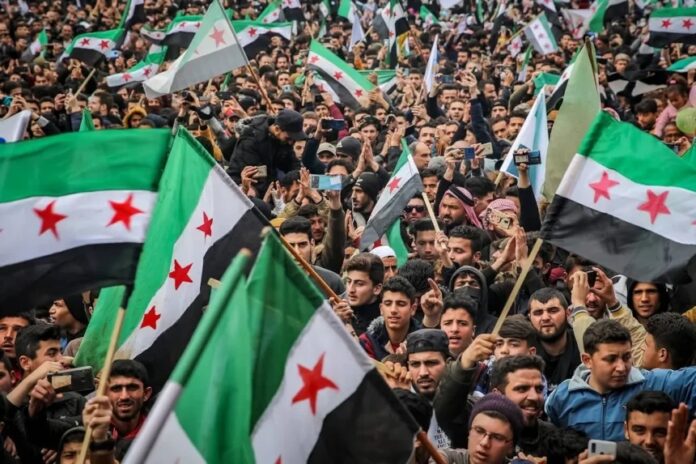In recent discussions about the future of Syria, some have drawn comparisons between the modern Syrian context and Medina (Yathrib) at the time of the Prophet Muhammad’s (peace be upon him) migration. These opinions often suggest that Syria is ready to become an Islamic state, citing historical precedents and prophetic methodology as evidence. While these ideas may appear compelling at first glance, a deeper examination reveals significant flaws in their reasoning. This article aims to dismantle these flawed arguments and provide a realistic understanding of the challenges facing Syria today.
The Problem with Comparing Syria to Medina
One common argument is that modern Syria resembles Medina on the eve of the Prophet’s migration. However, this comparison is fundamentally flawed and constitutes Qiyas Ma’al Farik (analogy with significant disparity). The geopolitical, social, and military circumstances of Medina in the 7th century CE bear little resemblance to the realities of Syria today:
- Tribal Autonomy vs. Nation-State Dynamics:
- Medina existed as a tribal entity with internal disputes but no external military occupation. In contrast, Syria operates as a nation-state under significant external influence. Foreign military bases from the United States, Russia, and other nations dominate Syrian territory, and Kurdish forces control significant regions in the northeast. External interference complicates any attempt to establish indigenous governance, let alone an Islamic state.
- Fragmented Support for Islamic Governance:
- Proponents of this view often assert that Syrians aspire to Islam and have united against oppression. However, there is little evidence to demonstrate widespread, cohesive support for establishing an Islamic state. Activists working for Islamic governance have faced arrests, and the lack of unity among factions in areas like Idlib undermines claims of broad support.
- Geopolitical Context:
- The 7th-century Arabian Peninsula’s geopolitical environment was relatively insulated, with threats primarily from neighboring tribes. In contrast, Syria is entangled in global geopolitics, with major powers like the United States, Russia, and Israel shaping its future. This complexity makes comparisons to Medina overly simplistic and misleading.
Misunderstanding Prophetic Methodology
Another claim is that Syria meets the prophetic criteria for establishing Islamic governance: public opinion ready to embrace Islam and sufficient strength to protect and uphold the religion. While these principles are valid, they are misapplied in this context:
- Public Opinion:
- The Prophet Muhammad (peace be upon him) migrated to Medina only after securing the allegiance (bay’ah) of its leaders and a clear commitment to Islamic governance. Where is the equivalent in Syria today? There is no evidence of a unified or significant faction pledging allegiance to the establishment of Sharia.
- Strength:
- The Prophet’s migration was accompanied by a strategic plan to consolidate power and address Medina’s challenges. Syria, by contrast, remains a fragmented society with multiple factions vying for control. External forces and internal divisions weaken any claim of sufficient strength to establish and protect an Islamic state.
Ignoring the Realities of Modern Syria
Some argue that “The West…is in crisis and losing its influence,” implying that this creates an opening for Islamic governance in Syria. This assertion is baseless. Western powers continue to exert considerable influence over Syria through military, economic, and diplomatic means. Moreover, the suggestion that Sharia will resolve all social and economic issues oversimplifies governance challenges.
Misuse of Historical Analogies
The argument often relies on historical references, such as the statement by Asad ibn Zurara about Medina’s internal divisions and its potential for unity under Islamic governance. While Asad’s statement highlighted Medina’s fragmented state, it also emphasized the critical role of unified leadership and the Prophet’s guidance. In Syria, such unity and leadership are conspicuously absent, making the analogy irrelevant. Selective use of historical quotes out of context only weakens the argument further.
The Path Forward
Drawing flawed analogies and oversimplifying complex realities does little to advance the discussion about Syria’s future. A genuine assessment of Syria’s readiness for Islamic governance must:
- Acknowledge the challenges posed by foreign occupation and internal division.
- Present clear, evidence-based pathways for unifying the people and establishing governance.
- Avoid relying on simplistic comparisons to historical contexts that do not align with present realities.
Conclusion
The idea that Syria is ready to become an Islamic state based on parallels to Medina is deeply flawed. Unsupported claims, misapplied prophetic methodology, and unrealistic assumptions undermine the credibility of this argument. A meaningful discussion about Syria’s future requires engaging with the realities on the ground and addressing the structural and geopolitical barriers to progress. Without this, any attempt to draw comparisons to Medina risks misleading its audience and oversimplifying the challenges ahead.

